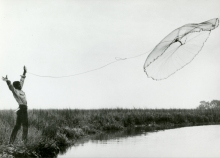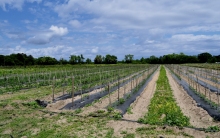Conserve: Protect something, especially of environmental or cultural importance,
from harm or destruction. Prevent the wasteful overuse of a resource.
Our natural landscape: Forest, marsh and water
John’s Island has long been overlooked by outsiders as a rural backwater. Since the late twentieth century it has been seen by many as a road to the neighboring resort islands, at best a quaint byway to one’s retirement residence, at worst an obstacle to pass through on the way to a beach vacation.

Click to enlarge
Recent decades have witnessed a growing appreciation of Johns Island’s stunning beauty, especially by visitors. Our live oak hardwood forests provide abundant habitat for wildlife. Our marshes are among the most productive ecosystems on the planet. All life here is constrained, sustained and shaped by water. Native Islanders have long benefited from nature’s bounty, and enjoy and respect its gifts.
The Conservancy supports many efforts to protect natural habitat and wildlife, preserve functioning ecosystems and keep the island beautiful.
But without better public access to that beauty, we risk creating an island where everything scenic lies behind a private gate. Johns Island needs controlled access to our waterways and natural spaces opened to the public. Reasonable access will in turn foster support for conservation efforts.
Our story: Heritage, history and culture

Click to enlarge
Though the modern island is just two bridges and 25 minutes removed from peninsular Charleston, life here evolved in distinctly separate ways from the late 17th century to the mid-20th century. The Island’s story is a European story and an African story, yet neither is complete without the other. Even during the eras of slavery and segregation, Johns Island culture was interwoven in often surprising ways. Ultimately it is an American story.
Q&A with Bill Saunders: ‘Johns Island means everything to me.’
Our working landscape: Farms, food and family
In addition to Johns Island’s value as a functioning ecosystem, its 84 square miles are also home to more than 17,000 people, some of whom can trace their family histories back to the colonial era. To this day, many of those ancestral legacies are written not in monuments, but in the island’s remarkably fertile fields.
Demand for residential development continues to drive up land prices here. The unique combination of factors that make Johns Island a desirable place to live also make it one of the best location in the country for growing fresh produce year round. This advantage and ready access to the greater Charleston market gives local farmers a fighting chance.
Sidi Limehouse Q&A: ‘I’m optimistic. To an extent.’
Conserving by growing

Click to enlarge
Nearby Charleston is the birthplace of the historical preservation movement in the United States. This success brings both lessons and controversies. Which past is worth “preserving?†The 18th century version, or the 19th century version, or the Disneyland version? In conserving one thing, is another destroyed? And when we act to preserve a culture, or a forest, or a working farm, how do we avoid unintended consequences that ultimately make matters worse?
As islander elder Bill Saunders put it, “I believe that places should function. And any time you start preserving them, or conserving them, you’re killing the thing. You’re putting it in a jar and putting it on a shelf somewhere.â€
Which brings us to one of the puzzles in conservation. If a thing worth passing along to future generations is being threatened or destroyed, and preserving it as we remember it effectively kills it, how do we teach the values represented by those things to our children? The answer is to is change it. Not to “make it better,†or to appropriate it, but simply to update its value to make it more viable in the modern world. What adapts, sustains. What sustains, survives.
Thomas Legare Jr. Q&A on agritourism: ”Which do you want?’
‘Rural’ preservation isn’t the point
Spend any time studying the problems of rural life across the United States and you’ll find programs aimed at revitalizing remote small towns and shoring up farm-based economies. But the conditions these programs address – neglect, population loss, low property values and dwindling opportunities – simply don’t match the realities we face here. If anything, Johns Island is struggling to deal with the implications of growth and demand, not neglect and decline.
With that in mind, we’re cautious with how we use the word “rural.†Isolation kept Johns Island’s identity rural until the late 20th century. But we are also located within a growing metropolitan area with a population of 700,000 people. Our proximity to Charleston and the resort islands has led many to conclude that Johns Island has no future but urbanization – that widespread residential and commercial development is at best a public good, and at worst inevitable.
We propose an alternative view: Johns Island’s proximity to its urban neighbors presents us with a series of double-edged swords, each of which can be handled either well or poorly.
- Yes, the proximity to a growing urban area and the relatively short commute to downtown drives up property values for suburban development. Yet it also gives John Island farmers easy access to one of the best markets in the Southeast. High-quality fresh fruits and vegetables, free-range meat and artisanal dairy products are key ingredients in Charleston’s dining renaissance .
- Yes, the Lowcountry’s success as a travel destination puts Johns Island under development pressure. Yet the tourism and vacation trade also values our natural and working landscapes. That value can create economic opportunities for residents who take advantage of them.
- Yes, technological and social changes threaten to overwhelm traditional values and lifestyles. Yet these changes can also be used to create innovative solutions to the problems we face.
TABLE OF CONTENTS
Murray Neale Q&A: The future of horses and people.
With those principles in mind, we went in search of ideas and opportunities for the island. We offer these not as a complete record of every opportunity out there, but as the beginning of a discussion that we hope leads to action.

 Growing a New Johns Island - Introduction
Growing a New Johns Island - Introduction